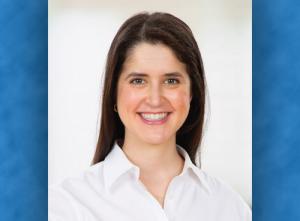New York PSC
Caroline Wolfe is Special Assistant to the Chair of the New York Public Service Commission.
Energy affordability is a tough subject to grapple with but is on the minds of utility leaders and regulators everywhere as they lead the charge in the energy transition. It is a big picture subject that requires a look at all costs faced by energy and utility companies.

The issues are made even more difficult in that a utility’s customers, and those with affordability challenges, are not a homogeneous group with uniform circumstances. It’s a lot to figure out and it is a subject that requires much information and discussion.
Here, Public Utilities Fortnightly examines the issues surrounding affordability challenges with leaders in the know. You can learn much from New York Public Service Commission Special Assistant to the Chair Caroline Wolfe.
PUF’s Steve Mitnick: What is your role at the New York Department of Public Service/Public Service Commission?
Caroline Wolfe: I joined the Department three-and-a-half months ago as Special Assistant to Rory Christian, the Chair of the Public Service Commission and Chief Executive Officer of the New York State Department of Public Service. Before that, I served as Senior Policy Advisor for Energy in the Governor’s Office, where I played a key role in shaping and executing New York State’s energy policies. My team worked closely with state energy agencies and authorities, including the Department and Commission, to drive strategic initiatives forward.
In my current role, I bring that policy expertise into the regulatory sphere, helping to navigate the complex challenges of transitioning New York’s energy system. The Department’s role has evolved significantly over the past decade. While ensuring just and reasonable rates remain core to our mission, those rates are now deeply intertwined with how we fund and implement the clean energy transition. I’m excited to continue leading this critical work, ensuring that our policies not only accelerate progress but also protect ratepayers and maintain a reliable grid.
PUF: This issue of energy affordability is a top issue, right?
Caroline Wolfe: Absolutely. It’s top of mind for everyone. As we go through the energy transition, the key is ensuring that the narratives align and that our investments in clean energy are safeguarding a more affordable energy future.
By transitioning to renewable energy, we lessen our exposure to fossil fuel prices, which are becoming more volatile due to extreme climate events and more complex geopolitical realities. Hedging against these future risks and protecting consumers from higher costs is one of the many benefits of the transition. Benefits that will only grow in significance in future years.
American-made clean energy means energy security. I think this is sometimes overlooked. And long-term energy affordability means making sure everyone can pay for this essential service, to heat their homes in the winter and stay cool in the summer.
The Commission has a goal of keeping energy rates across the state below six percent of household income. We have a variety of different mechanisms to try to achieve that goal, through top-down and bottom-up interventions.
The bottom-up, or customer-focused, mechanisms have the most potential. Costs are only going to go up unless we empower customers. Empower them with the tools and opportunities to do things differently. Engage them with information and knowledge so they can make decisions that lower their costs. Enable them to maintain their quality of life at a reasonable cost.
PUF: You divided what the state is doing in affordability into two categories: top-down and bottom-up, or customer-focused. Give an idea of what most affects energy affordability for New Yorkers.
Caroline Wolfe: I’ll take one step back before I get into those two buckets. Utilities are not immune to the broader economic realities that we’re seeing. There are compounding macro- and micro-economic pressures of high interest rates, inflation, supply chain disruptions, and COVID-19.
The role of the Commission is to help manage those pressures and try to keep energy as affordable as possible. When we say energy affordability, what does that mean? I have a background in environmental anthropology, so I can’t help but ask the questions, affordability for whom and to what end?
That’s critical here. Energy or electricity is an essential service. Our role as regulators is to ensure the system can benefit all New Yorkers and we must work to ensure all our efforts work in concert to achieve that outcome. Brownouts, blackouts, customers unable to pay their bills; that’s not tenable.
I want to focus on the customer-sided efforts first. We have various demand-response programs at the Commission. One program, responsible for over a hundred megawatts of flexible load, allows utilities to manage the load of residential customers during times when the grid is under stress.
There are about two dollars in benefits to New Yorkers for every dollar spent on these programs. And this is by managing air conditioning use in residential homes.
We see great potential with integrating technologies to enable customers to better manage their load. That’s why we’re exploring how to expand this program to include battery storage systems.
We also started looking at how we can deploy flexible assets, such as virtual power plants, to maximize the grid’s resources. There’s a study underway that will be published in the next couple of months, a precursor to a final plan.
Now, let’s touch on the top-down efforts. Energy affordability is baked into the eleven-month rate-case process. The Department scrutinizes every line item of our utilities’ costs.
Over the last year, we’ve avoided over four-hundred-million dollars in costs to ratepayers. But over one-million households still rely on the utility-run energy affordability programs, and we anticipate that number will grow as additional eligible households are identified and enrolled.
Other funding efforts, including the elimination of over one-billion dollars in COVID-19 arrears, and hundreds of millions per year in energy bill credits, have been boons for affordability, but we know that many households still struggle to pay their bills every month. We are doing everything in our power to change that.
PUF: Do customers qualify in a certain way, perhaps by being in a federal assistance program?
Caroline Wolfe: Yes. Customers currently qualify for the energy affordability program if their household income is below sixty percent of state median income. This will soon extend to moderate-income households, as well.
Customers can demonstrate this to utilities by identifying their enrollment in state and federal programs, such as the home energy assistance program or Medicaid.
What we’re taking a close look at is how best to identify and reach these customers directly.
Assistance programs with overlapping eligibility requirements offer that potential. In fact, if a customer receives the home energy assistance program benefit, they are automatically enrolled in a utility’s energy affordability program.
PUF: Automatic enrollment is key because a lot of customers don’t know about a program, or don’t think they’re eligible for whatever reason. What is New York’s approach?
Caroline Wolfe: In addition to the automatic matching that already takes place, we’re continuously exploring opportunities to advance other data-matching opportunities to enroll new low-income and moderate-income participants and actively improving outreach in the process. We expect automatic enrollment nexuses to grow over the coming years.
But it can be overwhelming for folks who don’t engage as closely with their energy bill beyond identifying, “It’s very high this month,” and feel they can’t pay it and will go into arrears. Data matching is key to streamlining the process behind the scenes.
PUF: You’re measuring energy affordability using the six-percent energy burden metric. How does that work?
Caroline Wolfe: I can zoom into one program to highlight this. A pilot program called the Energy Affordability Guarantee is actively being launched.
In alignment with state goals, the pilot is designed so that low-income customers that fully electrified their homes through a state program called EmPower Plus would pay no more than six percent of their household income on electricity costs.
It’s an innovative way of thinking about how to fully electrify households in a way that preserves energy affordability.
PUF: What’s the future in New York for energy affordability?
Caroline Wolfe: I want to focus on three key things. First, continuing to strengthen and expand the energy affordability program through continued engagement with an energy affordability program working group to ensure all eligible households are enrolled and are receiving a right-sized benefit.
Second, it’s homing in on flexibility. Making sure customers are aware of and enroll in the existing demand-response programs and continuing our efforts to integrate new technologies and resources. This can lower monthly bills and avoid costly grid investments, in turn decreasing the overall cost of the transition for ratepayers.
Third, it’s ensuring that the necessary system investments are future proofed to withstand the effects of a changing climate. The Commission recently approved climate change resilience plans from many of the state’s utilities and started the process to standardize extreme heat protections. These protections will focus on how to mitigate energy and cost burdens for New Yorkers.
PUF: How do you cope with income diversity, but also diversity of New York being a big state with upstate people who drive a lot and live in single-family homes, while in the city, many live in apartments?
Caroline Wolfe: There’s not a one-size-fits-all approach. In New York, we have several utilities working across the state. Some are electric-only, some are gas-only, some are gas and electric.
The Department takes an intentional approach to working with each utility, understanding what their major constraints are, what their customer base is like, from a geographic and a socioeconomic perspective, and tailoring affordability programs to meet those customers where they’re at. That’s the primary way we work toward those goals.
PUF: What is the most rewarding in your role or what you are looking forward to having an impact on?
Caroline Wolfe: My focus, both in the Governor’s Office and now at the Department, has always been to drive real, measurable progress in New York’s clean energy transition. We’re at a defining moment, where the urgency of the climate crisis demands bold action, and the economic, political, and social landscape adds complexity to how we move forward.
At the Department, I’m excited to tackle these challenges head-on, not just within our own agency, but across state government and beyond. It’s about upholding the tenets of energy affordability while aligning policies, ensuring a reliable grid, and advancing a cleaner, more resilient energy future. This is not an easy task, but I’m committed to delivering real results for New Yorkers. This is the time to lead, and I intend on fully leaning into this moment.
Affordability conversations at fortnightly.com:



